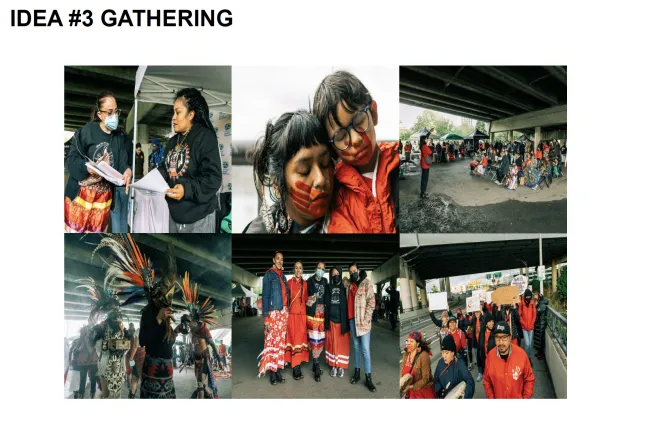Imagine: You are walking down the streets of Portland when you look across the street and find a building covered — from top to bottom, side to side — an image of someone’s face, their beautiful eyes are staring back at you.
That’s what Samantha Hanlin, storytelling producer at INDÍGENA, hopes to have up and running by Nov. 1: a series of 10 portraits of Indigenous people, all either projected or pasted across buildings in the County. And her goal is to have it done in time to kick off National Native American Heritage Month.
Hanlin, appearing before the Board of Commissioners on Oct. 6, described this project as “an opportunity to build bridges through art.” She was among a pair of speakers who shared their connections to Indigenous Peoples Day as part of a proclamation declaring Monday, Oct. 10, 2022, as Indigenous Peoples’ Day in Multnomah County.
The nationally celebrated day recognizes Native American, Alaskan Native and Indigenous people and their heritage across Turtle Island, an ancestral name for North America and the lands that now contain the United States. The day also recognizes the progress that still needs to be made and the resilience of the community.
“This is a policy document that is a public record and acts as a reminder of where we are and whose homeland we are on,” Chair Deborah Kafoury said of this year’s proclamation, marking the seventh year Multnomah County has honored Indigenous Peoples’ Day.
The name “Multnomah” stems from the Multnomah, who are a band of the Chinookan people.
The County’s proclamation specifically honors and celebrates the many contributions made by Indigenous peoples throughout the community, and it strongly encourages local businesses, organizations, public institutions, and community members to recognize Indigenous Peoples’ Day and to learn about the Indigenous community’s history and cultural significance.
“We acknowledge the multi-generational loss of life, loss of land, loss of water and waterways, loss of language, loss of children, and loss of culture due to the historical and ongoing colonization of this land that perpetuates the current structural barriers that impact the Native quality of life,” the proclamation states.
“Indigenous people are still here,” Hanlin said as she and photographer Josué Rivas, INDÍGENA’s founder, explained their cultural project.
Hanlin said the portraits would show a range of Indigenous people, whether activists, youth, or community members. The large public displays would not only make the art accessible to the community, but they would also provide visibility for the Indigenous community and create a chance for people to participate in conversations with those around them.
Raven Harmon, with the Future Generations Collaborative, read the proclamation in both English and Chinuk Wawa, one of the languages of the nine tribes in Oregon.
“We are still here. Indigenous People’s Day is an opportunity to acknowledge and celebrate the thriving traditions and deeply rooted values of the Indigenous peoples who reside in Multnomah County and their ancestors before them,” Harmon read.
Commissioner Sharon Meieran thanked Harmon for reading the proclamation in both languages. “You were amazing and moved me to tears,” she said.
“The project looks powerful,” Commissioner Susheela Jayapa said of INDÍGENA’s portraits, adding that the project offers a gentle way of sparking conversation.
Commissioner Jessica Vega Pederson thanked the presenters and noted the importance of proclamations like this one, “when government bodies do this work,” where historical oppression is acknowledged along with work to address what has happened.
“We see you, we see your bravery, we see your power, we see your spirit,” Commissioner Lori Stegmann said.
Chair Deborah Kafoury thanked Harmon for reading the proclamation in both languages and thanked Hanlin for partnering with her in building awareness and visibility through the portrait project.
“We're going to keep acknowledging our history in a way that centers and celebrates the people whose land we’re holding this meeting on. And we’ll back that up not just with words and a proclamation, but with actions and investments,” said Chair Kafoury.

